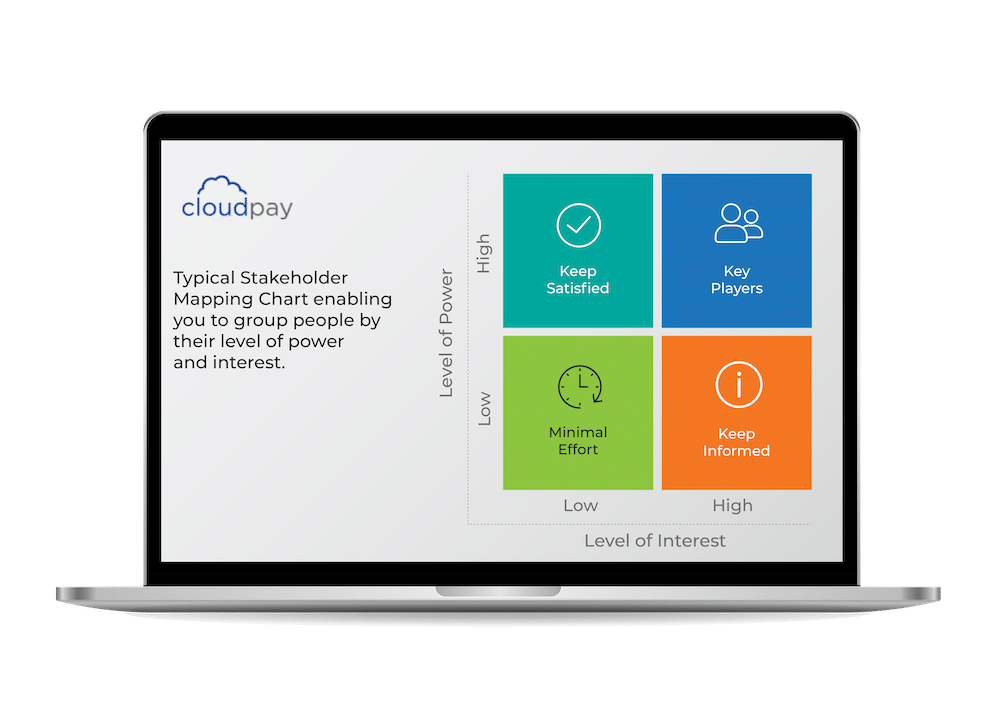There can be few internal business projects that truly impact every employee in an organization – but the roll-out of a global payroll solution is one.
The successful implementation of global payroll typically depends on your ability to manage the people side of the process as much as the technical side, requiring both the tactile and tactical engagement of a particularly high number of stakeholders.
In part two of this blog, we’ll look at exactly who those stakeholders are, where their interests lie and how to engage them to maximum effect. For this article, we focus on stakeholder mapping as it relates to enabling successful change management processes and consensus building.
Identifying your stakeholders
Some of the key challenges of a global payroll transformation (such as a lack of local knowledge, integration with HCM or achieving standardization) can only be overcome through close cooperation and collaboration with stakeholders across your worldwide operations.
But before you can produce a plan for communication and engagement, you need to establish to what level their interest, involvement and influence in the project extends.
It’s not enough to simply acknowledge that everybody has a vested interest in your payroll project. A robust stakeholder strategy relies on a level of detail that addresses group interests and priorities, and pinpoints the teams or individuals whose engagement will be critical. This insight is best achieved through the process of stakeholder mapping – a fundamental starting point for a successful stakeholder engagement strategy.
The stakeholder mapping process begins with identifying and grouping your key stakeholders. In a large global business, this may take some time.
Start with those who have an obvious, direct relationship to the project – your vendor’s team, your own payroll and HR teams, and those providing the resources, approvals and investment. Then work backwards to include the people or teams that they rely on, to build a full 360 picture of everyone involved.
In a global payroll software implementation, your groups will likely be split by both region and function, leaving you with a collection of stakeholder groups similar to the below:
- Local/regional payroll managers
- Local/regional HR directors and managers
- Local/regional IT and HR systems managers
- Business unit management
- Central finance
- Audit, risk and compliance teams
- HR shared service center leaders
- C-suite – Chief People Officer, Chief Finance Officer and Chief Technology Officer
- Global payroll vendor team
Analyzing the key players
Once you have identified your list of stakeholder groups, you can start to plot their positions on a simple chart of ‘influence’ vs ‘interest’.
First, assess what level of interest the group has in the project. How important is it to them? How much does it impact them? How much involvement will the project require of them?
Then, consider their level of influence. To what degree are they able to exercise power and control over the project? This isn’t just a question of seniority (though of course that will be a factor) – it should also take into account those with recognised expertise or authority in the field.
Naturally, every organization’s stakeholder map will look different, but an example is shown below. By dividing the chart into four sections, you’ll emerge with four clear sets of stakeholders.

The four stakeholder sets, and how to engage them
High power / High interest
Crucial to the project’s success in every sense, the ‘high power / high interest’ stakeholders will become the prime focus of your engagement strategy.
These are people not only highly invested in the project, but who also wield the influence to push your project through or to encourage adoption. Conversely, they may also have the power to derail it.
These groups must therefore be managed closely, with near constant communication through all stages of the project, and a clear commitment to building trust.
To manage these groups effectively, you’ll need a detailed understanding of their specific project interests, priorities and concerns. Significant work must therefore be undertaken to evaluate and analyze the interests of these stakeholders above all others – something we cover in detail in part two of this blog.
High power / Low interest
Low interest groups may not be greatly involved or affected by your payroll project – but those with significant influence must still be kept satisfied.
Indeed, it could be argued that these stakeholders are more likely to use their power to the project’s detriment, as its implementation doesn’t bring them any direct benefit.
Be mindful here of stakeholders who think they’re more involved or affected than they actually are. Overlooking any person of influence in the business could prove to be a costly mistake.
Low power / High interest
With every employee ultimately affected in some way by a global payroll project, many of your stakeholders will sit in this category.
While they may not have the power to hamper the implementation itself, their adoption of the solution will be all-important, so they should be kept informed and engaged through periodic communications that make them feel a part of the project.
Low power / Low interest
With little interest or influence in the payroll project, these low-priority stakeholders are often overlooked in the engagement strategy.
However, contact should undoubtedly be maintained with these groups, who are the only stakeholders able to give an impartial insight to proceedings.
It’s also important to remember that stakeholder status can easily change over the duration of the project – so keeping these groups in the loop could end up being more important than you realise.
Stakeholder Mapping: Summary
Stakeholder engagement is fundamental to the success of any new payroll implementation, but many organizations fail to adequately identify and prioritise the project’s key players.
This can leave communications with critical stakeholders too light and infrequent, failing to generate the support required – while engagement with less invested stakeholders is excessive and overbearing.
Stakeholder mapping helps ensure the avoidance of these project pitfalls, and underpins the development of an engagement strategy that speaks to the interests and priorities of all parties (discussed here in part two).
However, organizations must be aware that stakeholders’ influence and interest is always subject to change. Engagement plans must therefore be reviewed on a regular basis, to ensure the strategy remains effective even after launch.



